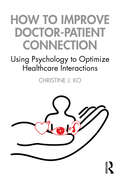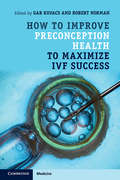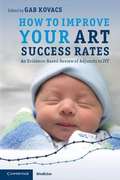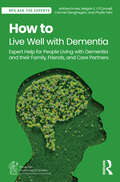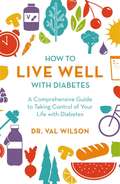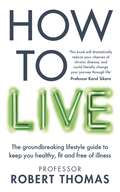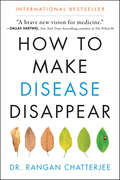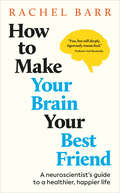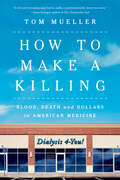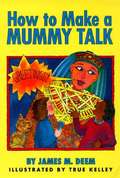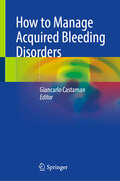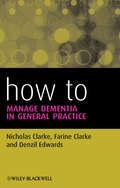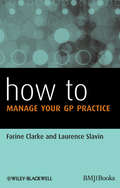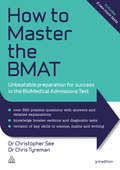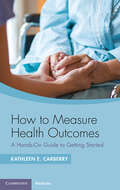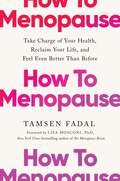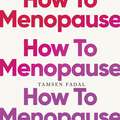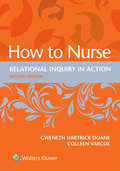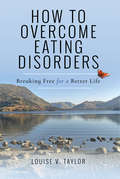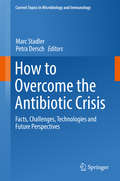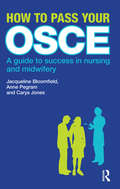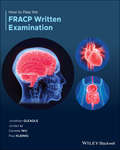- Table View
- List View
How to Improve Doctor-Patient Connection: Using Psychology to Optimize Healthcare Interactions
by Christine J. KoHow to Improve Doctor-Patient Connection offers actionable steps for improving communication between health professionals and patients based on visual, auditory, and emotional understanding from the principles of cognitive psychology. Drawing on the author’s personal experience as both a healthcare professional and a mother of two children, How to Improve Doctor-Patient Connection explores communication between doctors and patients as well as bias in healthcare. This how-to text includes several practical applications that can be applied to healthcare encounters, enabling readers to form habits based on visual analysis of body language, auditory information from language and tone of voice, and logical emotion perception that will allow for improved doctor-patient connection. By integrating the perspectives of both doctors and patients and applying a psychological lens, this text is invaluable to healthcare practitioners, students of medicine, healthcare, biology, and related fields, and anyone looking to improve their own or other’s quality of doctor-patient interactions and overall healthcare experience.
How to Improve Preconception Health to Maximize IVF Success
by Gab Kovacs Robert NormanIn order to maximize the chance of IVF success, couples need to ensure that their preconceptual health is optimal to increase the quality of gametes and reproductive fitness. This text reviews the medical and lifestyle factors that can affect the body at preconception stage, such as micronutrients, stress, hormonal and gynecologic assessment, as well as environmental factors such as optimal weight and age for childbirth. This book will enable all medical practitioners and healthcare professionals to give evidence-based advice to influence the success rate of subsequent IVF cycles, and ensure that every child is born in the best possible condition. Part of a four-book series on optimizing different aspects of the IVF cycle, this book focusses on preparing the body for assisted conception. Other books in the series focus on the egg and embryo, the endometrium, and the sperm.
How to Improve Your Art Success Rates
by Gab KovacsIVF is now established worldwide as a clinical service. Units are striving to improve their success rates, and many treatments are being advocated as 'yet another breakthrough'. The purpose of this book is to help clinicians to evaluate each of these new treatments. Each chapter is written by a recognized international expert in the field and the chapters are short and succinct, summarizing the latest evidence-based information for each topic and treatment. Sections cover patient selection and preparation, the role of AIH before IVF, stimulation, monitoring, laboratory techniques, embryo transfer, ancillary treatments and assessment of results. How to Improve your ART Success Rates: An Evidence-Based Review of Adjuncts to IVF is essential reading for all clinicians working with infertility and assisted reproduction, and is also a valuable addition to any medical library.
How to Live Well with Dementia: Expert Help for People Living with Dementia and their Family, Friends, and Care Partners (BPS Ask The Experts in Psychology Series)
by Anthea Innes Megan E. O’Connell Carmel Geoghegan Phyllis FehrHow to Live Well with Dementia: Expert Help for People Living with Dementia and their Family, Friends, and Care Partners provides an array of essential guidance about the different aspects of dementia for all whose lives are touched by dementia, including people living with dementia and their support network.Following an effective Q&A framework, this book offers valuable, easy-to-navigate guidance on the burning questions that those living with a dementia diagnosis and their carer/supporter need to know. Questions addressed include ‘How can I adjust to life with the diagnosis?’, ‘How can I plan for the future?’, and ‘How can we support our loved ones living with dementia?’. It provides expert explanations about changes in the brain and the various causes and types of dementia, as well as support on how to adjust to living with a diagnosis. It also offers practical information about care planning and advanced directives, maintaining health and social connections, accessing appropriate community care, and supporting medical and hospital care. It concludes with important self-care information for care/support partners.Written jointly by academic experts and experts through lived experience, this book is indispensable for people living with dementia, care partners, and anyone wanting to understand more about the condition, as well as health and social care professionals and students of health and social care.
How to Live Well with Diabetes: A Comprehensive Guide to Taking Control of Your Life with Diabetes
by Dr Val WilsonThe essential guide to living well with diabetes, written by an expert who has lived with the condition for more than four decades.Whether you are newly diagnosed or have been living with diabetes for some time, this book will help you understand your diagnosis so you can manage and live well with your diabetes for as long as possible. Every aspect of your life with diabetes is covered - from diet, sex and exercise to mood changes, managing blood glucose levels and physical complications arising from the condition. Dr Val Wilson draws on more than four decades of managing the condition and on her professional experience to help readers deal with their diagnosis, consider how it will affect their relationships and lifestyle, with advice on DAFNE for Type 1 diabetics and ways that Type 2 diabetes can eventually be reversed. Real-life case studies show other people's experiences of diabetes-related issues that you might also be dealing with.This is the only book you need to learn how to self-manage diabetes.
How to Live Well with Diabetes: A Comprehensive Guide to Taking Control of Your Life with Diabetes
by Val WilsonThe essential guide to living well with diabetes, written by an expert who has lived with the condition for more than four decades.How to Live Well with Diabetes is a comprehensive self-help guide for people with the condition, either newly diagnosed or for those who've been living with diabetes for some time. This book has been written to help you understand your diagnosis so you can manage and live well with your diabetes for as long as possible. Every aspect of your life with diabetes is covered - from diet, sex and exercise to mood changes, managing blood glucose levels and physical complications arising from the condition. Dr Val Wilson draws on four decades of personal and professional experience to help readers deal with their diagnosis, consider how it will affect their relationships and lifestyle, with advice on DAFNE for Type 1 diabetics and ways that Type 2 diabetes can eventually be reversed. Real-life case studies show other people's experiences of diabetes-related issues that you might also be dealing with.Around 700 people each day are diagnosed with diabetes - that's the equivalent of one every two minutes. In January 2016, Diabetes UK announced that four million people in Britain now have diabetes of one form or another. This is the only book they need to help self-manage the condition.
How to Live a Healthy Life: A Handbook to Better Health
by Jan de VriesHow to Live a Healthy Life is an indispensable handbook which outlines the approach to health of one of the world's foremost homoeopaths, Jan de Vries. It gives sensible and easy-to-follow advice on a huge number of subjects, ranging from maintaining a healthy liver and building strong bones to how to follow a well-balanced and nutritious diet and cope with stress.
How to Live: The groundbreaking lifestyle guide to keep you healthy, fit and free of illness
by Professor Robert ThomasDid you know:· that drinking a glass of red wine after sunbathing can reduce lasting skin damage?· that your choice of deodorant can affect your long-term health?· that some houseplants are more effective in removing air toxins than others?In How to Live, Professor Robert Thomas, one of Britain's leading oncologists and an expert in integrating nutritional and lifestyle strategies into cancer treatment, gives us effective, scientifically proven advice about everything from diet and exercise to sleep and skincare.As Thomas explains, through achievable changes to our daily routine we can improve the expression of our genes - helping us beat the odds of cancer and chronic disease. We discover, for example, why drinking a glass of red wine after sunbathing can reduce lasting skin damage; and why some houseplants are more effective than others in removing air toxins.This is a health bible for life. Whether you are in your 20s or 70s, it will help you to empower your body against ageing and degenerative disease and live at maximum strength.
How to Live: The groundbreaking lifestyle guide to keep you healthy, fit and free of illness
by Professor Robert ThomasDid you know: <P><P>that drinking a glass of red wine after sunbathing can reduce lasting skin damage? <P><P>that your choice of deodorant can affect your long-term health? <P><P>that some houseplants are more effective in removing air toxins than others? <P><P>In How to Live, Professor Robert Thomas, one of Britain's leading oncologists and an expert in integrating nutritional and lifestyle strategies into cancer treatment, gives us effective, scientifically proven advice about everything from diet and exercise to sleep and skincare. <P><P>As Thomas explains, through achievable changes to our daily routine we can improve the expression of our genes - helping us beat the odds of cancer and chronic disease. We discover, for example, why drinking a glass of red wine after sunbathing can reduce lasting skin damage; and why some houseplants are more effective than others in removing air toxins. <P><P>This is a health bible for life. Whether you are in your 20s or 70s, it will help you to empower your body against ageing and degenerative disease and live at maximum strength.
How to Make Disease Disappear
by Rangan ChatterjeeA much-needed program to prevent and reverse disease, and discover a path to sustainable, long-term health from an acclaimed international doctor and star of the BBC program Doctor in the House.How to Make Disease Disappear is Dr. Rangan Chatterjee’s revolutionary, yet simple guide to better health—a much-needed, accessible plan that will help you take back control of your health and your life.A physician dedicated to finding the root cause of ill health rather than simply suppressing symptoms with drugs, Dr. Chatterjee passionately advocates and follows a philosophy that lifestyle and nutrition are first-line medicine and the cornerstone of good health. Drawing on cutting edge research and his own experiences as a doctor, he argues that the secret to preventing disease and achieving wellness revolves around four critical pillars: food, relaxation, sleep, and movement. By making small, incremental changes in each of these key areas, you can create and maintain good health—and alleviate and prevent illness. As Dr. Chatterjee, reveals we can reverse and make disease disappear without a complete overhaul of our lifestyle.His dynamic, user-friendly approach is not about excelling at any one pillar. What matters is balance in every area of your life, which includes:Me-time every dayAn electronic-free Sabbath once a weekRetraining your taste budsDaily micro-fastsMovement snackingA bedtime routinePractical and life-changing, How to Make Disease Disappear is an inspiring and easy-to-follow guide to better health and happiness.
How to Make Your Brain Your Best Friend: A Neuroscientist's Guide to a Healthier, Happier Life
by Rachel BarrYour brain is the most remarkable thing in the known universe.Fun, but still deeply, rigorously researched.' - Professor Neil Shyminsky'A true masterpiece. Rachel Barr has done a phenomenal job breaking down the complexities of the human mind.' - Jeffrey Meltzer, LMHC'Insightful and relatable psychoeducation that demystifies the brain . . . it&’s a resource I&’ll proudly keep on my shelf as a therapist.' - Joshua Fletcher, anxiety therapistAlways trying to mend itself, and always trying to protect you, it&’s in a constant state of flux — adapting, reconfiguring, finding new pathways . . . And it has an astonishing capacity for recovery.Only it doesn&’t always get it right.Rachel Barr struggled through years of devastating loss, heartache, and uncertainty until neuroscience gave her the first spark of self-belief she had felt in her adult life — and proof that, because of the brain&’s near-infinite potential for neuroplastic change, it&’s never too late to carve out neural pathways to form new habits, new skills, and new ways of thinking.Whether you want to nerd-out on Neuroscientific acronyms, finally understand what&’s going on in your head, or take refuge in a book that&’s like a warm hug for your mind, How to Make Your Brain Your Best Friend is a delight-filled, evidence-based guide to taking better care of your brain — so it, in turn, will take better care of you.
How to Make a Killing: Blood, Death And Dollars In American Medicine
by Tom Mueller“Inspiring and deeply distressing.” —Ezekiel J. Emanuel, author of Which Country Has the World’s Best Health Care? How did a lifesaving medical breakthrough become a for-profit enterprise that threatens many of the people it’s meant to save? Six decades ago, visionary doctors achieved the impossible: the humble kidney, acknowledged since ancient times to be as essential to life as the heart, became the first human organ to be successfully replaced with a machine. Yet huge dialysis corporations, ambitious doctor-entrepreneurs and Beltway lobbyists soon turned this medical miracle into an early experiment in for-profit medicine—and one of the nation’s worst healthcare catastrophes. With powerful insight and on-the-ground reporting, New York Times best-selling author Tom Mueller introduces an unforgettable cast of characters. Heroic patients, including a Hollywood stuntman and body double, risk their lives to blow the whistle on how they’ve been mistreated. An unpaid activist living in a south Georgia trailer park fights to save patients from involuntary discharge from their lifesaving care. Industry insiders put their careers on the line to speak out about the endemic wrongs and pervasive inequality they’ve witnessed—and about dialysis executives who dress as musketeers and Star Wars characters to exhort their employees to more aggressive profit-seeking. Mueller evokes the scientific ingenuity and optimism of the 1950s and 1960s, when the burgeoning field of organ transplant and early dialysis machines offered long-awaited hope for lifesaving care. That is, until a New York salesman had himself dialyzed on the floor of the House, and Congress made renal disease the only “Medicare for All” condition—opening the financial floodgates for Big Dialysis. Of the thousands caught in a web of corporate greed, a disproportionate number are Black and Latino, highlighting the stark racial divides already endemic to American medicine. How to Make a Killing reveals dialysis as a microcosm of American medicine and poses a vital challenge: find a way to fix dialysis, and we’ll have a fighting chance of fixing our country’s dysfunctional healthcare system as a whole, restoring patients, not profits, as its true purpose.
How to Make a Mummy Talk
by James M. DeemIn this funny, fact-filled book, author James M. Deem takes readers on a mummy-discovery tour that spans centuries and continents. He explains exactly what mummies are, how they are created, where they have been found, how scientists investigate them, and what they tell us about the people who lived long ago.
How to Manage Acquired Bleeding Disorders
by Giancarlo CastamanThis "transversal" book is a valuable resource not only for hematologists but also for clinicians who may encounter acquired bleeding situations that they must manage, even if they lack access to a bleeding disorder specialist. The discussed conditions are relatively prevalent and can lead to frequent bleeding complications of varying severity, such as bleeding during anticoagulant therapy. The book also covers the significance of disseminated intravascular coagulation, another common complication that varies in severity based on the underlying condition that triggered it. This book fills a void by addressing these common complications in a single resource that will prove beneficial to medical professionals in training and specialists in various medical fields who treat patients with specific clinical condition.
How to Manage Dementia in General Practice (How To)
by Farine Clarke Nicholas Clarke Denzil EdwardsThis practical guide clearly shows each stage in the management of a patient with dementia. It covers the complex issues surrounding dementia such as spouses and families, access to appropriate care, legal and ethical concerns, planning for the future and "living well" and includes the decision making process on initiating treatment and guidance on how best to access the available services.
How to Manage Your GP Practice
by Farine Clarke Laurence SlavinThe business side of running a medical practice may be unappealing but it's crucial How to Manage Your GP Practice is written for GPs and other health professionals running their own practices.It tells you in simple, engaging style what the pitfalls are and how to avoid them.It illustrates the good and bad ways of negotiating through management issues, using case examples and lightening the messages with witty cartoons. Written by a GP with over 10 years' experience editing a leading GP magazine, and an accountant whose firm advises over 2500 GPs, the information here is sound, relevant and up to date. It provides reliable and reassuring information for doctors starting out in their careers as well as those looking to refresh their management skills.
How to Master the BMAT
by Chris John Tyreman Dr Christopher SeeHow to Master the BMAT will help you to maximize your BMAT test score in the shortest time possible with the least possible effort. With over 400 practice questions including six mock tests, it focuses on core knowledge in six key areas: -aptitude and skills -maths -physics -chemistry -biology -writing tasks At the end of each section, a set of review questions enable you to identify and improve your weak areas before you sit the test, then once you are ready you can complete the practice papers that reflect the BMAT test. Candidates are supported throughout the book, and, where possible, every question comes complete with its revision topics indicated in brackets, useful hints and expanded answers.
How to Measure Health Outcomes: A Hands-On Guide to Getting Started
by Kathleen E. CarberryComplementing existing literature on measuring health outcomes that is largely conceptual, this book focuses on simple, practical advice for measuring outcomes in a variety of settings. Written in an engaging conversational tone, readers will learn why measuring health outcomes is necessary in clinical practice and how these measures may vary between people and across care structures. Covering how to identify measurements as well as collect and analyze the data, the chapters lead readers through a series of logical steps to scaling up a measurement program. The workbook style allows readers to record their own notes and thoughts throughout the book, while the list of action steps at the end of chapters are tangible starting points for developing a measurement program of their own. Explores how to measure and think about outcomes in a way that sees the whole person, not just the medical or behavioral condition they have.
How to Menopause: Take Charge of Your Health, Reclaim Your Life, and Feel Even Better than Before
by Tamsen FadalEXPERT-DRIVEN, GIRLFRIEND-APPROVED - The menopause manual that cuts through the chaos so you can take back control of your body, your confidence, and your life, from Emmy award-winning journalist, documentary filmmaker, and social media powerhouse Tamsen Fadal.What's happening to me? Is anyone else feeling this way? Why did no one tell me about this?If you're ready to feel like yourself again, this book is "the talk" you never had.How To Menopause is packed with actionable steps and evidence-based tools from a team of 42 experts including neuroscientists, menopause-certified physicians, sex and relationship therapists, sleep doctors, and a variety of lifestyle mentors.Synthesizing research, stories, and strategies in a way that only an investigative journalist can, Tamsen Fadal helps you- be your best advocate in a medical system not designed to treat women in midlife,- understand the options that tame your symptoms, whether it's hormone therapy, supplements, or lifestyle changes,- have science-backed strategies to get the best sleep of your life,- be able to talk to your partner about sex, low libido, painful intercourse, or how your hormones might be impacting your relationship,- update your style (hair, makeup, clothes) to match your changing body,- learn simple workouts, skincare tips, and delicious recipes to deal with belly fat, dry skin, and hair loss (and don't worry, it's not all kale salads)--and much, much more.How to Menopause answers all the questions you've been too nervous to ask, and brings you into a conversation with millions of other women. Together, we can embrace a stronger, sexier self at every stage of midlife-from perimenopause through menopause and into our "bolden" years."How to Menopause is more than just advice--it provides a lifeline. Through her honesty, humor, research, and relentless commitment to women's health, Tamsen Fadal has created a guide that is both practical and deeply personal. Whether you're just beginning to experience perimenopause or well into this transition, these words will leave you feeling more confident, more informed, and most importantly--never alone." --Lisa Mosconi, PhD, New York Times bestselling author of The Menopause Brain
How to Menopause: Take Charge of Your Health, Reclaim Your Life, and Feel Even Better than Before
by Tamsen FadalEXPERT-DRIVEN, GIRLFRIEND-APPROVED - The menopause manual that cuts through the chaos so you can take back control of your body, your confidence, and your life, from Emmy award-winning journalist, documentary filmmaker, and social media powerhouse Tamsen Fadal.What's happening to me? Is anyone else feeling this way? Why did no one tell me about this?If you're ready to feel like yourself again, this book is "the talk" you never had.How To Menopause is packed with actionable steps and evidence-based tools from a team of 42 experts including neuroscientists, menopause-certified physicians, sex and relationship therapists, sleep doctors, and a variety of lifestyle mentors.Synthesizing research, stories, and strategies in a way that only an investigative journalist can, Tamsen Fadal helps you- be your best advocate in a medical system not designed to treat women in midlife,- understand the options that tame your symptoms, whether it's hormone therapy, supplements, or lifestyle changes,- have science-backed strategies to get the best sleep of your life,- be able to talk to your partner about sex, low libido, painful intercourse, or how your hormones might be impacting your relationship,- update your style (hair, makeup, clothes) to match your changing body,- learn simple workouts, skincare tips, and delicious recipes to deal with belly fat, dry skin, and hair loss (and don't worry, it's not all kale salads)--and much, much more.How to Menopause answers all the questions you've been too nervous to ask, and brings you into a conversation with millions of other women. Together, we can embrace a stronger, sexier self at every stage of midlife-from perimenopause through menopause and into our "bolden" years."How to Menopause is more than just advice--it provides a lifeline. Through her honesty, humor, research, and relentless commitment to women's health, Tamsen Fadal has created a guide that is both practical and deeply personal. Whether you're just beginning to experience perimenopause or well into this transition, these words will leave you feeling more confident, more informed, and most importantly--never alone." --Lisa Mosconi, PhD, New York Times bestselling author of The Menopause Brain
How to Nurse: Relational Inquiry in Action
by Colleen Varcoe Gweneth Hartrick DoaneConfidently address the theory-to-practice gap and equip your students with a theoretically sound, research-informed approach to successful nursing practice. How to Nurse: Relational Inquiry in Action, Second Edition, focuses on the “how” of relational inquiry to demonstrate the relevance of nursing research and help students confidently navigate the complexities of real-life nursing practice. A conversational writing style makes concepts accessible and engaging learning tools link conceptual ideas to clinical action to prepare your students for safe, competent nursing practice. UPDATED! Revised content reflects the most current practices informed by the latest evidence-based research. NEW! Relational Inquiry Toolbox features highlight knowledge, strategies, inquiry frameworks and checkpoints to strengthen your everyday nursing practice. To Illustrate features reinforce key concepts with real-life examples of patients and families, former students, practice nurses and clinical nurse specialists. Try it Out activities challenge you to engage with chapter content and apply concepts in a range of ways. Text Boxes summarize essential relational inquiry ideas and strategies at a glance. Figures and Images clarify the relationship between ideas and stimulate your critical thinking capabilities. Learning Objectives help you prioritize chapter content and make the most of your study. An Example stories illustrate key points in the text.
How to Overcome Eating Disorders: Breaking Free for a Better Life
by Louise V. TaylorIf you want to gain a better understanding of eating disorders, including anorexia, bulimia and binge eating disorder, this book is for you. It looks at theories about the causes of eating disorders, including susceptibility studies, personality traits, genetics, the effects of personal circumstances, societal/media pressures, family influences and more.The health risks are covered and the damage caused by eating disorders is made clear. This information, especially, will help some sufferers find the strength and determination to fight their disease and break free.The book explains the logic of eating disordered individuals, with some using food or weight control as a coping mechanism to block out painful emotions. It will enable the reader to better understand why some people with eating disorders behave as they do.It looks at the latest research, and new and emerging treatments are discussed, as well as established treatments and their success rates. In addition to conventional treatments medical, psychological and therapeutic the book considers complimentary therapies that may support an individual's recovery.It also includes nutritional information, to help those who are frightened of food, because they feel out of control around it, or are afraid of being overweight. There is a chapter on adjusting to change, recovery strategies and a look at why pro-ana communities are unhelpful, suggesting healthier social groups and past-times.The book contains extensive case studies of people who have battled with anorexia and bulimia, looking at some of the things that may have played a role in their disease, such as abuse, bullying, loneliness, low self-esteem, unhappiness and pressures to conform.
How to Overcome the Antibiotic Crisis
by Marc Stadler Petra DerschThis volume focuses on antibiotics research, a field of topical significance for human health due to the worrying increase of nosocomial infections caused by multi-resistant bacteria. It covers several basic aspects, such as the evolution of antibiotic resistance and the influence of antibiotics on the gut microbiota, and addresses the search for novel pathogenicity blockers as well as historical aspects of antibiotics. Further topics include applied aspects, such as drug discovery based on biodiversity and genome mining, optimization of lead structures by medicinal chemistry, total synthesis and drug delivery technologies. Moreover, the development of vaccines as a valid alternative therapeutic approach is outlined, while the importance of epidemiological studies on important bacterial pathogens, the problems arising from the excessive use of antibiotics in animal breeding, and the development of innovative technologies for diagnosing the "bad bugs" are discussed in detail. Accordingly, the book will appeal to researchers and clinicians alike.
How to Pass Your OSCE: A Guide to Success in Nursing and Midwifery
by Carys Jones Jacqueline Bloomfield Anne PegramThe Objective Structured Clinical Examination (OSCE) was developed for all undergraduate nursing programmes, with the aim of emphasising the need for nursing students to be competent in clinical skills, to assess clinical reasoning skills and as a means of standardizing the assessment process. This practical, easy to read and interactive study guide helps nursing and midwifery students at all levels to maximise their chances of success with OSCEs. It features case studies, quick quizzes, recap and recall summaries and an OSCE preparation plan; all of which help to prepare the student for the examination. Hints and tips on what to expect during the examination and pointers on what the examiner will be looking for, together with a comprehensive chapter on personal learning will help to guide the student through the process and maximise their chances of success!"Very readable with useful tips and information for students" Cath Hill, Keele University"I found the book extremely relevant from the students' perspective, reader friendly and well structured. Quizzes and activities excellent." - Liz Day, Senior Lecturer, Nursing and Health Care Practice, University of Derby "A useful and easily digested text on this important assessment strategy", Ms. Karen Lumsden, Faculty of Nursing and Applied Clinical Studies, Canterbury Christchurch University"Useful for students as they prepare... Easy to read and understand."Kirsty Wedgbury, Faculty of Health and Community Care, Birmingham City University
How to Pass the FRACP Written Examination
by Danielle Wu Jonathan Gleadle Jordan Li Paul KleinigHow to Pass the FRACP Written Examination is an indispensable review and study guide for anyone preparing for the challenging Fellow of the Royal Australasian College of Physicians (FRACP) exam. This up-to-date resource fully aligns with the current FRACP core training curriculum, containing a wealth of traditional multiple-choice questions (MCQs) as well as extended-matching questions (EMQs). There are hundreds of questions for every major topic of the written examination, including critical care medicine, cardiology, infectious diseases, immunology and allergy, neurology, and pharmacology. More than a simple practice exam, this guide provides clear and complete explanations of each answer, a mini-review of the subject, and links to the most recent or relevant articles on the topic. Complementing the main body of questions are a number of ‘teaching’ and two-step questions—designed to strengthen clinical reasoning skills, highlight important issues, and expand knowledge of contemporary ‘hot’ topics. Written by an experienced team of physicians and educators, this must-have book: Provides a thorough review of the latest FRACP basic training syllabus Features QR codes embedded in the text to enable quick access to all references Offers tips, hints, advice, and examination strategies from previous candidates Provides numerous questions grounded in clinically relevant cases Covers of areas of medicine that are new, contemporary, and evolving Covering both the ‘Basic Sciences’ and ‘Clinical Practice’ of the latest exam, Passing the FRACP Written Examination is an essential companion for FRACP candidates as well as those looking to refresh, improve, or update their knowledge of the FRACP syllabus.
